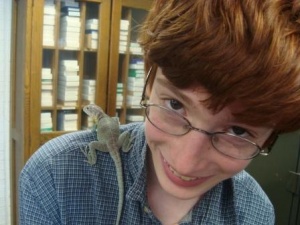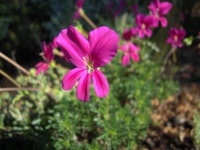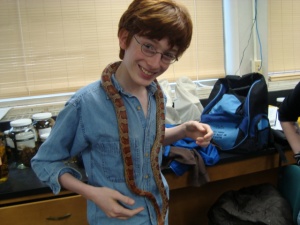Colin Carlson
I am a fourth semester honors double degree student in EEB (B.S.) and IMJR - Environmental Studies (B.A.), currently studying plasticity in the genus Pelargonium. I was also named a 2010 Udall Scholar for my environmental work on and off campus.
Contents
Research Interests
Phenotypic plasticity; environmental law and conservation biology; society-environment interactions.
Snapping Turtle Research
This project analyzed the behavior of three Snapping Turtles (Chelydra serpentina) along the Connecticut river. The footage, collected over the summer, was from three turtles: Jawless and Lafayette from Wethersfield Cove, and Snippy from Shenipsit Lake. (see the snapping turtle research team page for the full story on the turtles). Also, for more information on Crittercam itself, visit National Geographic's Crittercam Homepage. This analysis encompasses the breath, dive, pausing, walking, and other aspects of locomotion of the three turtles. If you would like to read more about the actual data analysis going into the project, check out Snapping Turtle Research: Analyses and Conclusions.
My research on this project was divided into two main stages. First came an analysis of the duration and frequency of breathing and diving behaviors, an analysis that revealed a strong positive relationship between breath and dive duration. Second, I analyzed behavioral patterns in the turtles through an analysis of locomotion divided into five sub-categories, and found strong differences between their average limb frequency cycles.
Pelargonium Plasticity
"All is leaf, and through this simplicity the greatest multiplicity is possible." - Johann Wolfgang von Goethe
After working for a year on the Snapping Turtle Research project, and helping it get to that glorious moment of publication, I’ve finally turned to my thesis research, on light-induced leaf shape dimorphism in South African Pelargonium L’Her (Geraniaceae). To some degree the focus of this research can be condensed into the following three questions:
1. Is leaf shape actually plastic? (The "what?")
2. Does selection appear to act on plasticity iself, and at what spatial/phylogenetic levels? (The "why?")
3. Are leaf traits evolved independently in their plasticity, and is there any suggestion of evolutionary/environmental constraints on these traits and/or there plasticity? (The "how?")
During the summer of 2010 I traveled to South Africa with the NSF IRES 2010 group to measure leaf shape variation in a natural context, including with the help of a CCB Summer Undergraduate Research Award; I am currently planning a series of greenhouse experiments primarily examining light plasticity, in particular in the context of interspecific differences, as well as the degree to which leaf shape traits may be constrained by factors such as humidity and temperature (e.g. It is well established in the literature that leaf dissection is strongly positively correlated to higher evaporative water loss; if dissection is positively, plastically associated with light level, then field plasticity may be reduced because of the thermal effects of high light on EWL, but may be more pronounced in the lab due to reduced water constraints.)Along with all of these research questions, an "ultimate" goal of my research is to begin to understand why an already-diverse genus should also have plasticity - that is to say, whether the plasticity facilitated the evolution of the diversity of leaf shapes in the genus, or whether plasticity acts completely separately from selection (either because the plasticity is non-adaptive or because it acts at a different phylogenetic/spatial level from selection). In many ways, Pelargonium is an ideal model organism for testing theories of phenotypic plasticity and adaptive radiation given its surprisingly-high diversity and impressive degree of plasticity (unpublished data), and for this reason, could have far-reaching consequences as a case study of diversification, specialization and adaptive plasticity.
Conservation Philosophy and Career Aspirations
"I know the human being and fish can coexist peacefully." - George W. Bush
One of the major problems that faces conservation and environmental advocacy is that advocates don't get the environment, and environmental biologists aren't skilled advocates. This gap between activism and science is one that I have found to be a major obstacle in my environmental work as director of the Cool Coventry Club and steering comittee member of the Connecticut Youth Activist Network, and is one that has shaped my career goals profoundly. More about me: I'm part of the EcoHouse living community on campus (and will continue to be next year), a member of environmental organizations such as EcoHusky, and recently found out I was awarded a 2010 Udall Scholarship for my environmental work!! This scholarship will be invaluable to me, as it involves a week-long training conference in Arizona this summer, which will give me more tools to spread my environmental message. After UConn, I plan to go to graduate school to receive my Ph.D., but I won't stop there - law school seems to be a reasonable next step. After all, science and policy should go hand in hand - so even though I might end up in either field, both degrees will be of use to me.
Publications
Landberg, T., Carlson, C. J., Abernathy, K., Luginbuhl, C., Gemme, P. and Mergins, C. (2010) Natural History Notes: CHELYDRA SERPENTINA SERPENTINA L. (Eastern Snapping Turtle). SURVIVAL AFTER INJURY. Herpetological Review 41(1):70-71.



